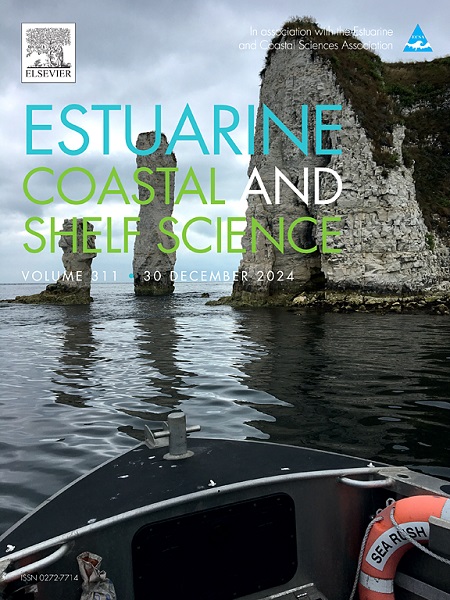Trace metal concentrations in the bulk and non-sinking suspended particulate matter of the Gaoping River plume after heavy rainfall events
IF 2.6
3区 地球科学
Q1 MARINE & FRESHWATER BIOLOGY
引用次数: 0
Abstract
Between May and September, monsoon rains contribute 99.8 % of the water flowing down the Gaoping River annually, and an even greater percentage of the suspended particulate matter (SPM) discharged to the coast. The Gaoping River links vast amounts of highly erodible sedimentary material to the marine environment, creating turbid plumes at the freshwater-marine interface. Climate warming is projected to increase the intensity of flood events and the amount of erosion in the river catchment, yet the export processes delivering this material to the offshore environment are poorly quantified. In this study, particulate organic carbon (POC) and trace metals were measured in the SPM collected in surface waters of the river plume after moderate, strong and very strong pulses of freshwater discharge. Both the bulk and non-sinking portions of the SPM had a terrigenous origin and were not distinguishable from each other based on their trace metal contents. Particulate metal contents primarily depended on SPM concentration and increased continuously with decreasing SPM, i.e. when progressing towards the open sea. A striking result was that the non-sinking SPM discharged to the coast exhibited only a 3-fold increase in response to a 10-fold increase in river discharge and 400-fold increase in total SPM. This may reflect the limited supply of organic compounds responsible for imparting a stabilising surface charge on these mineral particles. Despite representing a very small percentage of the total SPM, the non-sinking SPM was shown to be a potentially important and long-lived transport vehicle for river-derived metals in the surface circulation of the South China Sea.
强降雨后高平河羽流体悬浮颗粒物和非沉降悬浮颗粒物中痕量金属的含量
在5月至9月期间,季风性降雨贡献了每年99.8%的高平河径流量,并且更大比例的悬浮颗粒物(SPM)排放到海岸。高平河将大量易侵蚀的沉积物质与海洋环境联系在一起,在淡水-海洋界面形成浑浊的羽状物。预计气候变暖将增加洪水事件的强度和河流流域的侵蚀量,但将这些材料输送到近海环境的出口过程却很少量化。本研究采用中、强、强三种脉冲淡水排放方式,测定了在河羽地表水中采集的SPM中颗粒有机碳(POC)和微量金属的含量。SPM的主体部分和非下沉部分均为陆源成因,其微量金属含量难以区分。颗粒金属含量主要依赖于SPM浓度,并随着SPM的减小而持续增加,即随着SPM向公海移动而增加。一个显著的结果是,当河流流量增加10倍时,排放到海岸的非下沉SPM只增加了3倍,而总SPM增加了400倍。这可能反映了负责给这些矿物颗粒提供稳定表面电荷的有机化合物的供应有限。尽管在总SPM中所占的比例很小,但非下沉SPM被证明是南海表面环流中河流衍生金属的潜在重要和长期运输工具。
本文章由计算机程序翻译,如有差异,请以英文原文为准。
求助全文
约1分钟内获得全文
求助全文
来源期刊
CiteScore
5.60
自引率
7.10%
发文量
374
审稿时长
9 months
期刊介绍:
Estuarine, Coastal and Shelf Science is an international multidisciplinary journal devoted to the analysis of saline water phenomena ranging from the outer edge of the continental shelf to the upper limits of the tidal zone. The journal provides a unique forum, unifying the multidisciplinary approaches to the study of the oceanography of estuaries, coastal zones, and continental shelf seas. It features original research papers, review papers and short communications treating such disciplines as zoology, botany, geology, sedimentology, physical oceanography.

 求助内容:
求助内容: 应助结果提醒方式:
应助结果提醒方式:


